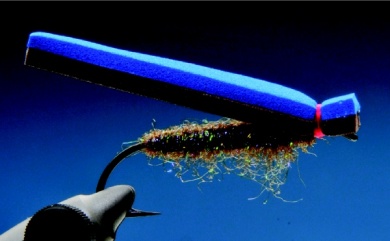Most adult dragonfly imitations have the same defect: the wings that we can see in commercial flies make a terrible sound when cast, and also tangle up the line, making us use thick tippets; and therefore limiting our chances to catch fish by leaving the fly still on the lake surface.I have solved t View more...Most adult dragonfly imitations have the same defect: the wings that we can see in commercial flies make a terrible sound when cast, and also tangle up the line, making us use thick tippets; and therefore limiting our chances to catch fish by leaving the fly still on the lake surface.I have solved that problem, with the G Dragon, by replacing those wings with translucent silicon rubber that floats and moves in an irresistible way on the water surface. This way it´s also easier to tie the body and it´s really resistant to abuse and fish strikes. The foam layers, the thorax material, makes it impossible to sink; something that comes in handy on rough waters, when it becomes highly effective. When the lake surface is frizzy you can let it drift freely, the movement of the wings is enough to make it work. If the water is still, you can strip very slowly and make it vibrate. You can use fine tippets if you are going for those trout that have already seen too many flies.
Move the mouse over the image to zoom in the fly.
Touch the image to zoom in the fly.

List of materials
Tying MaterialsThread: 3/0, blue.Hook: Daiichi 2271 or Mustad Signature 9575, sizes 8 to 2.Dubbing: Hareline ice dubbing, brown olive.Body: Rainy´s 4mm foam. This one is 2mm, blue and brown together.Wings: flat silicon rubber, pearled with painted highlights.Over thorax: deer/elk body hair.
Steps
Step 1
Starting close to the hook eye (I recommend to do it with a loop), dub the thread and the underbody, first towards the hook bend and then back towards the hook eye.
Step 2
Cut a long triangular piece of foam. It should not be thicker than the hook gap and it should get thinner towards its tip.
Step 3
Tie the foam body with the blue thread, sticking two rubber straps of 2 mm, colors blue and brown. The blue one against the body. We can use any color combination, the results do not seem to vary much. Blue and brown are common in adult dragonflies; this is why I use them. I have tried greens and reds with similar results. Once we finished the first section, do the knot and cut the thread.
Step 4
One by one, we will have the sections of the fly. We could choose not to cut the thread but this would make weak spots on the fly. We need around 5 thread turns to make 4 sections.
Step 5
In the second section attach the silicon wings. The tightness will make the angle of inclination. Use two rubber straps at each side, not too apart nor too close to each other.
Step 6
We just need to add a deer hair that enables us to see the fly in the distance. We can use whitetail deer, mule deer, or elk (this is a bit rigid). I prefer whitetail deer hair that comes dyed in several colors.







